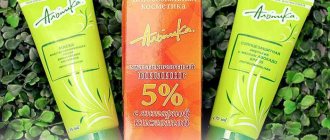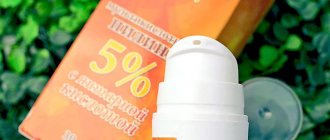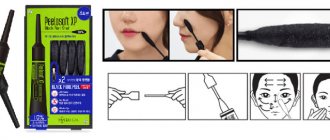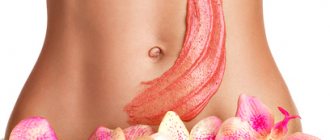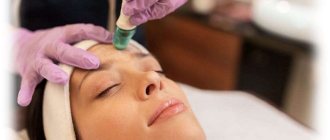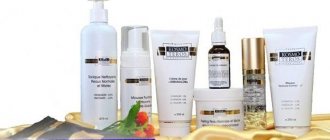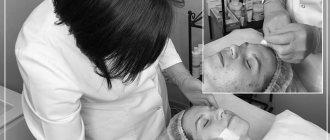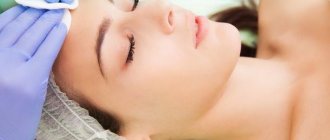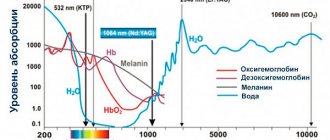Chemical peeling is a method of removing damaged outer layers of skin using acidic solutions.
In order to more effectively treat surface defects, eliminate wrinkles, and lighten age spots, a combination of several acids is used. Multi-acid facial peeling removes dead particles of the epidermis, revealing a renewed layer of skin, improving its tone, texture and color. Peeling with natural acids is one of the oldest cosmetic procedures in the world. It has been used since ancient Egypt to help women achieve more youthful and beautiful skin. Modern acid facial peeling is in steady demand, as it gives immediate visible results and allows you to solve many aesthetic skin problems.
offer
Features of multi-acid peeling
A typical acid peel uses only one type of acid. For example, glycolic is used to improve skin regeneration. Choosing one acid allows you to target problem areas, with less risk of irritation or allergic reaction, but also with a smaller spectrum of action. Depending on the substance used, chemical peeling can be superficial, medium or deep.
Multi-acid facial peeling is a procedure that acts on the surface layers of the skin, which combines various properties of organic acids for deep effects and maximum results. It is important to understand the differences, advantages and disadvantages of acids, and how these substances work on the skin individually and in combination with each other.
Indications and contraindications
Multi-acid peeling is prescribed for the following common skin problems:
- oily skin with enlarged pores;
- unhealthy complexion;
- acne;
- photoaging;
- hyperpigmentation;
- acne and post-acne;
- dry skin prone to flaking.
But this procedure is not suitable for everyone. Like any other chemical effect on the skin, it has a number of restrictions; the presence of at least one of them prohibits the use of the product. Contraindications include:
- inflammation of the skin of various nature;
- unhealed damage to the skin in the affected area;
- pregnancy and lactation;
- diabetes;
- epilepsy;
- herpes;
- increased photosensitivity of the skin;
- cardiovascular diseases;
- oncological diseases;
- individual intolerance to the components of the product.
If you carefully study the contraindications and do not ignore any of them, you can avoid very unpleasant, and sometimes dangerous, complications.
How does a combination of acids affect the skin?
By mixing different acids in one treatment, a professional can create cocktails that work simultaneously to solve different problems. However, some acids have a negative effect on each other when mixed, so it is not recommended to experiment with a combination of substances without knowing their properties.
KK Adapt. 5 paragraph
Modern manufacturers offer ready-made mixtures for multi-acid peeling. But when choosing a composition for the procedure, you need to be guided not only by what results you want to achieve, but also take into account the condition of the skin. The best way to find a formula that's right for you is to consult a dermatologist.
Reviews
Kate:
I bought a complex of Alpika and did a great job with the peeling myself. I did it once a week and used the whole jar. By spring, the skin noticeably whitened and became very smooth. Thus, I saved a lot on trips to beauty salons.
Marina:
I don’t like experiments on my appearance, so I had a multi-acid facial cleansing done by a specialist. It only took two procedures for the effect to be visible. I am 25 years old, but in the future I will do a more serious option - laser resurfacing or something similar.
Acids for multi-acid peeling
Multi-acid peeling uses the most popular natural acids. There are many types of refined organic acids that are gentle on the skin and work well together.
- Salicylic acid helps dissolve excess sebum and cleanse problematic skin, eliminates blackheads, and tightens pores.
- Glycolic - adds radiance and evens out rough or uneven skin, activates the collagen production process, and eliminates the first signs of age-related changes.
- Lactic acid is great for removing acne, smoothing fine lines, and lightening age spots.
- Citric acid is also used to treat acne and pigmentation;
- Appleseed helps solve problems such as rosacea and eczema;
- Almond is used to treat skin irritations, moisturize it and smooth out fine wrinkles.
- Succinic acid activates the process of cell renewal and restoration.
- Hyaluronic acid guarantees the activation of collagen and elastin synthesis, thereby increasing skin tone
Popular brands
The modern market is represented by a wide selection of multi-acid cleaning compositions from domestic and foreign manufacturers. Below are the most popular ones.
Alpika
Alpika line of cleansers (Russia):
- Peeling with mandelic acid 5%. Contains: mandelic, tartaric, malic, succinic and citric acids. pH level - 2.8. Volume - 30 ml/50 ml. Cost - from 1,700 rubles.
- Peeling with succinic acid 15%. Contains three active components: succinic, fruit (malic, citric, tartaric, grape) and glycolic acids. pH level - 2.8. Volume - 30 ml/80 ml. Price - from 1,600 rubles.
- Peeling Lactobionic Green 5%. Acids in the composition: lactobionic, malic, tartaric, almond. Volume - 30/80 ml. Cost - from 1,800 rubles.
Alpika serums have a complex effect on the skin. They allow you to regulate the depth of penetration of the cleansing mixture and the intensity of peeling of the epidermis. The action of the active components is aimed at restoring natural processes and cell renewal, gently exfoliating dead skin cells, and whitening the skin.
The procedure is carried out in courses - 5 sessions with an interval of 7 days. To maintain the results, peeling is done once a month.
Arabia
The range of popular Russian cosmetics is represented by peeling gels:
- "ANY-Time Contro" for all skin types. Ingredients: mandelic, lactic, salicylic acids. Cost - from 1,100 rubles.
- "KERATO-Skin Control" for any skin type. Contains: salicylic, lactic, glycolic, citric, malic, tartaric acids; extracts of apple, lemon, grape, sugar cane, blueberry fruits. Suitable for all skin types. Price - from 1,100 rubles. The drug can also be used to prepare the skin for medium peels.
- "REPARE-Skin Control" for dry and sensitive dermis. Active components: glycolic, succinic, gluconic acids, L-carnitine. Cost - from 1,200 rubles.
- "OILY-Skin Control" for oily skin. Contains: lactic acid, salicylic acid, glycolic acid, niacinamide. Cost - from 1,300 rubles.
Cleansers contain natural ingredients and are intended for home and professional use.
Gels are produced in 100 ml bottles. Each woman can choose the appropriate cocktail depending on the desired result.
Belita
This is a step-by-step professional complex of means that enhance each other’s effects. It includes:
- Pre-peeling makeup remover cream. Contains: fruit acids, vitamin E, wheat germ oil. Volume - 300 ml. Cost - from 400 rubles.
- Facial exfoliant cream with soft granules and active fruit ingredients. Volume - 200 ml. Contains: fruit acids, hyaluronic acid, vitamin E, wheat germ oil. The cream contains synthetic granules that give a scrubbing effect. The product ideally prepares the skin for subsequent exfoliation. Cost - 450-500 rubles.
- Peeling serum. Active ingredients: glycolic, lactic, citric acid. Volume - 300 ml. Has a pronounced lifting effect. Cost - from 700 rubles.
- Neutralizing tonic is a soft gel that prepares the skin for the completion of the procedure. Volume - 200 ml. Cost - from 500 rubles.
- Post-peeling protective cream SPF 15 - nourishes and moisturizes the skin. Volume - 200 ml. Price - from 500 rubles.
Exfoliation with the Belita complex is carried out in a course of 10 sessions (once every three days), then, to maintain the result - once every 1-2 weeks.
Myrrh
Almond peeling booster from MIRRA contains the following components: mandelic, glycolic, lactic acids, propylene glycol, azeloglycine, hydroxyethylcellulose, benzyl alcohol, glyceryl laurate.
pH level is 1.9. Volume - 50 ml. Cost - from 600 rubles. The product can be washed off with water, without using a neutralizer.
Effective and effective drugs are produced by the brands Ericson, Cleopatra, Mesopharm, GIGI, Christina, NOVACID.
How to do multi-acid facial peeling
The multi-acid peeling procedure is quite simple and does not require special preparation. A peeling agent is applied to cleansed skin with a special brush. The cosmetologist determines the contact time of acids with the skin individually. If you carry out the procedure yourself, then follow the average indicated in the instructions for the drug.
To neutralize the effect of acids, you cannot use regular washing, as some drugs, when in contact with water, can cause skin burns. In this case, a special product is used - a neutralizer, which is applied on top of the acid. And only after the action of the acids has stopped can you rinse the skin with water.
After peeling, use a soothing mask. And at the end of the procedure, a means of protecting the skin from external influences is applied.
Protocol 1
Intended for patients with acne in the comedonal or mild papulopustular stage. Glow Enhancing Peel is used at intervals of 7–10 days. The number of procedures is selected individually for each patient, but not less than four.
The peculiarity of this peeling, taking into account its pH and the acids included in the composition, is a comedolytic and anti-inflammatory, as well as brightening effect. At the same time, the concentration of acids and peeling pH allow the procedure to be carried out easily, without hyperemia and peeling.
Patient 1
Rice. 1
Rice. 2
Patient T., comedonal acne. From the anamnesis it is known that the rash has existed for about two years, has not been treated before, and has not visited a cosmetologist.
On examination: the facial skin is oily, open and closed comedones, papules and single pustules are noted (Fig. 1)
.
The Glow Enhancing Peel chemical peeling procedure was performed. A week after the procedure, pallor of the papules, a decrease in the severity of pores, and a decrease in sebum secretion are noted (Fig. 2)
.
Skin care after peeling
Skin after multi-acid peeling does not require a recovery period. However, it requires additional care. As a rule, manufacturers of acid peeling compositions also offer cosmetics for post-peeling care. It would be best to use this tool.
The first time after peeling, you should protect your skin from direct sunlight. You cannot visit the solarium, bathhouse or sauna. It is not recommended to go to the pool or actively engage in sports. All these restrictions are due to the fact that after the procedure the skin becomes easily vulnerable to the destructive effects of unfavorable factors: overheating, hypothermia, irritation from sweat, etc.
Stages of the procedure
Peeling using a product based on several acids is no different from its counterpart with any one acid. Approximately 2 weeks before the appointed date, you must stop visiting the beach and solarium, as well as the use of hormonal or painkillers. The procedure itself takes place in several stages:
- The skin is cleansed of cosmetics and impurities using a toner; if this is not done, bacteria can enter the skin, which can cause infection. Sometimes nourishing masks are used as a preparatory stage so that the skin better absorbs the active substance.
- The product is applied to the skin in a thin layer using a special brush. The concentration of acids, as well as the time of active exposure, is determined by a specialist, so you should carefully consider his choice; it is better to read reviews about his work on the clinic’s website. Parameters are calculated during a preliminary consultation.
- After the required time has passed, the product is removed using a special neutralizer; using water in this case can cause a burn. Only after the peeling has been completely removed from the skin, the cosmetologist wipes the face with napkins soaked in water.
- The last step is to apply a soothing cream or mask to the skin if the patient has enough time. This stage is very important, as it helps the skin cope with stress, which is chemical exposure.
This type of peeling is not very common in beauty salons; it is mainly used independently; products for it can be ordered on the Internet or purchased in specialized stores. The most famous brands:
- Multi-acid peelings "Alpika";
- Ericson Peeling;
- Mirra Professional (Glycolim series).
Chemical peeling: pros and cons
Peelings are now at the peak of popularity. In modern cosmetology, side effects are minimized, and consumers are fully informed about the procedure and the mechanism of action of acids. Samantha, the heroine of the TV series Sex and the City, with her face the color of ripe cherry, burnt after peeling, is becoming a thing of the past. As a result, only children are not taken to a beauty salon for peeling. Can acids really stop aging?
An excursion into history: when and where it all began
The concept of skin photoaging was developed in the 90s. It was then that scientists identified to the broad masses the main source of all troubles. According to this theory, almost all age-related changes - wrinkles, rosacea, pigmentation - occur due to damage caused by UV radiation and can be corrected if caught in time. The main weapons of the fight are acid peels, antioxidants (another magic word) and, of course, sunscreens.
The cosmetic market responded to the scientists' statements in the same way as always - offering a great variety of new products and procedures. This is how salon peelings, home peelings, serums with various concentrations of antioxidants and prices from 10 to 500 dollars, creams with AHA and BHA acids, sunscreens with nanoparticles and the absence of whitening effects appeared. New theories have also emerged that promise that nutritional supplements will prolong youth and beauty.
And yet, it is peelings that have become the most popular and most in-demand procedure among cosmetologists, in dermatological clinics and at home.
Chemical peels actually date back to ancient Egypt. The Egyptians successfully used lactic and fruit acids for this purpose. It is known for certain that Cleopatra took baths in sour milk and, without realizing it, was “peeled” with lactic acid. Her legacy did not sink into oblivion, but developed and improved. In 1882, salicylic acid, resorcinol and phenol began to be used in Europe. In 1930, peelings came to the United States thanks to Antoinette La Gosse, and from there, as they say, it went from there. Her protégé Cora Galenti made a fortune in Florida practicing wrinkle-smoothing peels.
In other words, controlled skin damage has a long history. Controlled, because that's what chemical peels are all about: using a combination of acidic agents to remove specific layers of skin. By varying the depth of exposure, it is possible to stimulate recovery processes, i.e., increase the production of hyaluronic acid, collagen and elastin, proteins that create a framework for maintaining skin elasticity.
Myths about peeling
Despite the large amount of reliable information explaining the actions and capabilities of peelings, some outdated beliefs and myths still persist. Consider them in order:
- The stronger the better.
“70% peeling with monoacid is better than 30%” - such reviews can often be found in various blogs. However, all aggressive exfoliation really does is strip away your skin and make the healing process more difficult. Doing this is not always the best solution. Modern peels combine several exfoliating acids - glycolic, lactic, azelaic, ferulic, phytic, etc. In addition, the composition often includes citrus extracts and vitamins, for example, retinol (vitamin A), antioxidants (most often resveratrol, genistein and vitamin E), as well as soothing agents (fireweed or aloe) to prevent irritation and redness. The practice has emerged of introducing detox agents and substances that stimulate microcirculation, such as coconut charcoal, into peelings. By reducing the concentration of each acid, combining several substances in one product, we get the maximum effect from each of the acids, while minimizing side effects - redness, burning, peeling. The composition of modern peelings enhances the penetration of antioxidants and vitamins included in the formula into the living layers of the skin. - Peeling
is a sign of peeling effectiveness. This is the most amazing misconception. Clients have repeatedly caused my cosmetologist friends to exclaim, “Oh my God, they want me to rip their skin off?!” Today, when developing peeling systems, along with efficiency, manufacturers are required to ensure maximum safety of the product and minimize side effects. The skin does not have to be “torn off”. There are systems that dissolve dead epidermal cells, usually these are “acid hybrids,” i.e., combinations of various acids, vitamins and antioxidants. The small size of the particles allows them to penetrate deep into the skin (act at the microscopic level). You have complete control over the process of removing damaged skin, smoothing its microrelief, brightening, moisturizing, smoothing wrinkles and restoring elasticity. The most commonly used combinations are retinol, encapsulated glycolic and lactic acids (15% glycolic + 5% lactic) or polyhydroxy acids. An example is gluconolactone; its acidic group is “masked” in the ring structure of the molecule, so it does not cause irritation when it comes into contact with the skin. These peels can be applied to the arms, neck and décolleté. They are suitable for even the most sensitive skin. In addition to improving peeling compositions, the procedures themselves are also being improved. Modern peeling consists of at least three standard blocks: skin preparation, peeling itself and completion of the procedure, which, depending on the needs of the skin, includes soothing gels, masks, and protection from UV radiation. Such procedures may include the alternate application of 5 to 10 drugs; the specialist builds an almost individual program. After completion, you do not see irritation and redness, but there is a positive trend that will intensify over the course of several months. - “Wounds” must take a long time to heal.
This point echoes the previous one, but here we are talking about medium and deep peels, which damage the basal layer of skin and dermis (located between the deepest layer of skin, subcutaneous fatty tissue and epidermis - the outer layer of skin). Of course, it is almost impossible to avoid side effects with medium and deep peels. One way or another, “wounds” form, you feel pain and burning, which can persist for several days or weeks. During the rehabilitation period, it is recommended to apply healing agents such as Panthenol, and in some cases antibiotic ointments. Crusts form on the face, it swells, then the skin cracks and comes off in layers. Thank God, all these horrors are already in the past. Products from modern manufacturers minimize discomfort during peeling and speed up the healing process after the procedure, while maximizing its overall effectiveness. For example, the most traumatic trichloroacetic acid (TCA - the “gold standard” of chemical peels) is today combined with phytic or glycolic acids. As a result, although “crusts” are still present after the procedure, they disappear much faster. In 3-4 days you will be able to lead your normal life, as opposed to 2-3 weeks with a traditional TCA peel. And the procedure itself is much easier than when applying pure acid. Many brands today include a modulator - a system of anti-inflammatory substances and antioxidants with a higher pH, this allows you to regulate the depth and area of peeling, and suppresses inflammatory reactions. Peels of this level are not necessary for everyone; they have previously been associated with certain risks, such as scarring and hyperpigmentation. Today, in order to increase the safety of the procedure and reduce the risks of complications, drugs with antioxidant protection are used at all levels. Special care at home is required, but thanks to the advent of cosmeceuticals, it is not difficult for a specialist to choose the right care.
If you think deep peeling will make you 10 years younger, it won't. Let's say you are 45, after peeling you will still look like a 45-year-old woman, but only fresh and well-groomed, rested and radiant.
- Only one procedure is needed.
In fact, the number of sessions is selected individually depending on the problems that need to be solved. For example, acne treatment often extends over many months and requires repeating the procedure every 2-3 weeks. Medium and deep peels can be performed once. It is commonly said that superficial peeling requires 7–10 sessions, but this is very arbitrary. Today there are systems that give visible results after the first use. Next, the client decides for himself whether he needs to consolidate the result; in this case, at least 5 procedures will be required. - There is no need to spend money on cosmetologists; chemical peeling can be done at home.
Rhonda Allison, founder and CEO of Rhonda Allison Clinical Enterprises, calls peeling an art form and argues that understanding and skill grows with experience—the more experienced the practitioner, the better the procedure and the better results you will receive. A full-fledged chemical peeling, even a superficial one, cannot be done at home, unless, of course, you are a cosmetologist-esthetician and have not been trained at a training center. All professional brands provide mandatory training. However, this does not mean that you cannot do anything at all. Products with a pH of at least 4.0 are allowed for home use. Basically, such products are classified as “preparation” for peeling. There are plenty of serums with fruit acids or combinations of acids - most with glycolic as the most popular on the market. These products are effective for exfoliating the uppermost scales of the stratum corneum and moisturizing - you should not expect miracles from home remedies. Another type of home peeling is enzyme peeling. They are able to dissolve dead skin cells, giving it a healthy, radiant appearance.
Chemical peels are experiencing a renaissance these days. The products are constantly being improved - burns, itching, and irritation with superficial peels are no longer a problem. Today it is a simple and safe cosmetic procedure that can help eliminate the signs of photoaging and partially correct the effects of biological aging.
The sooner you start using gentle peels, the better your skin will feel as you move into older age group. Preventing aging from the age of 20 will allow you to subsequently avoid many procedures. Regular gentle exposure of the skin to acids ultimately provides a lasting preventive effect. If deep wrinkles and nasolabial folds have already appeared, then even the deepest peeling will not give the effect that you would like to see.
Tatiana Morrison
Photo thinkstockphotos.com
Features of the procedure
Acids have a huge number of useful properties, which ensures their popularity in professional cosmetology. They quite quickly help get rid of blackheads, remove the stratum corneum of the skin, slow down the aging process and restore the functioning of natural processes in cells. Multi-acid peeling is safe and effective, and results can be obtained after the first use.
The peculiarity of this procedure is that it contains several components for a complex effect: fruit, succinic, glycolic, hyaluronic, salicylic and mandelic acids. This is one of the most gentle chemical procedures, which is suitable for use at any age and helps eliminate many problems. Each acid has specific functions, which allows you to combine components to obtain maximum effect in each individual case.
Benefits of using peeling for pigmentation
They accelerate the appearance of normally colored cells on the surface of the skin, thus speeding up the process of getting rid of pigmentation.
- Accelerates cellular renewal and exfoliation
- Allows you to quickly get rid of age spots
- The correct composition suppresses excess activity of melanocytes (lightens problem areas of the skin)
The leading advantage of peelings is that there is no need to apply an exfoliating composition every day; it is enough to visit a cosmetologist once every 2 weeks. If it is not possible to visit a cosmetologist, you need to use home peeling products.
Advantages
The main positive quality of multi-acid facial peeling is that it is an absolutely safe and gentle procedure that does not injure cells, but “awakens” them and restores natural processes. According to professional cosmetologists, it can be easily done at home, since there is no rehabilitation period required after exposure. The advantages of this procedure are as follows:
- efficiency, getting results after the first use;
- intensive hydration, elimination of dryness and flaking;
- cell renewal;
- restoration of the sebaceous glands;
- cleansing and narrowing pores;
- fight against the first and deep age-related changes;
- smoothing the relief and softening the skin;
- increased tone;
- alignment of natural shade and lightening of unwanted pigmentation;
- antibacterial effect;
- budget cost of special compounds;
- Possibility of use at different ages and for any skin type;
- does not require a lot of time.
Basic properties of acid
Lactic acid belongs to the organic group. It is formed during the breakdown of glucose. Since this substance is present in the human body (it participates in the process of carbohydrate metabolism and is one of the components that moisturize the skin), it is completely natural and absolutely safe in terms of allergies. In particular, peeling with lactic acid using Mediderma brand products is in great demand. This composition promotes high-quality cleansing of the skin and allows you to eliminate minor imperfections in its relief.
Indications for use
Multi-acid peeling is popular due to the fact that it is suitable for girls of different ages and with any skin type. This procedure must be performed if the following deficiencies are present:
- excessive work of the sebaceous glands;
- enlarged pores;
- black dots;
- heterogeneity of natural shade;
- dry skin;
- peeling;
- signs of aging;
- acne;
- unwanted pigmentation.
It should be noted that each component has certain functions that help to effectively influence and obtain results after the first use. Multi-acid peeling with succinic acid is aimed at restoring cell function, smoothing wrinkles and evening out the natural shade. Salicylic acid will become an indispensable assistant in the fight against oily skin, blackheads and enlarged pores, as well as acne.
Fruit acids create a protective barrier on the surface, intensively moisturize and restore elasticity. And glycolic and hyaluronic help the production of natural collagen, smooth out expression lines and age wrinkles, improve the natural tone and are ideal for dry skin.
Opinion of cosmetologists
Cosmetologists on forums actively share opinions about multi-acid cocktails for cleansing the epidermis. They call the main positive aspect quick results and high efficiency. Professionals note that products with a mix of active ingredients help solve a number of cosmetic problems, and a wide range allows you to choose a product for any skin type.
Instructions for carrying out
This procedure is quite easy and can be done at home. It is very important to take into account all stages of multi-acid peeling, use proven quality products and follow the recommendations of professional cosmetologists. Before the procedure, it is necessary to thoroughly clean the skin of impurities and decorative cosmetics. This can be done with micellar water and a quality cleanser.
Next, you need to apply any scrubbing product to the forehead, nose and chin that will help open the pores and thoroughly work out problem areas. After this, the multi-acid peeling product is evenly distributed onto clean, dry skin along the massage lines, left for 15 minutes for a deep effect and removed using damp cotton pads.
In order to soothe the skin and relieve redness, you can use a moisturizing mask, and after it, apply a suitable nourishing cream. After treatment, the skin becomes cleaner, smoother, wrinkles are smoothed out, the natural shade is restored, and the number of blackheads is noticeably reduced. With regular use, you can restore a beautiful and healthy appearance, and also significantly slow down the appearance of signs of aging.
